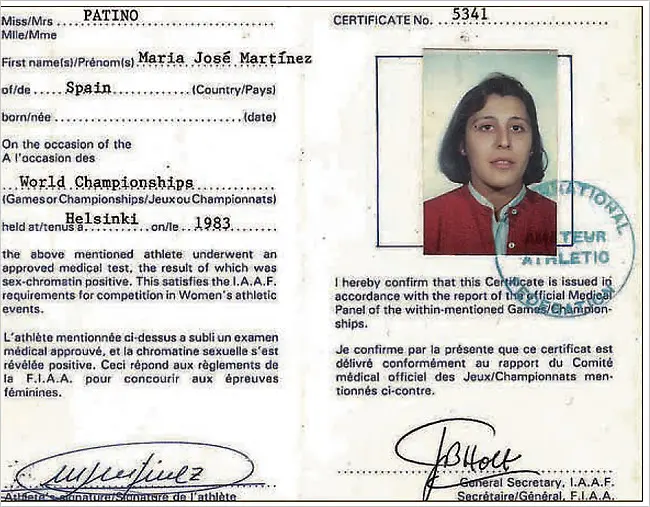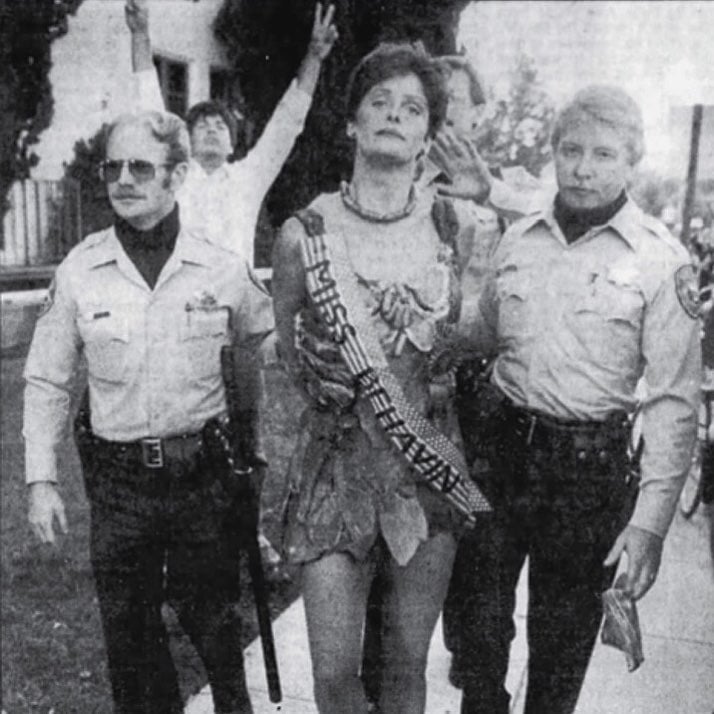TESTED EPISODE THREE: CARD CARRYING FEMALES

Episode Three: Card Carrying Females
We meet Kenyan sprinter Maximila Imali, who—like Christine Mboma—has been sidelined by DSD policies. She makes a different choice from Christine: to fight the regulations in court. And we learn that long before Max faced that choice, scientists, athletes, and journalists spent thirty years trying to end an earlier version of sex testing. In 1999, they finally succeeded… but the victory was short lived.
→ → → LISTEN HERE (or wherever you get podcasts) ← ← ←
For each episode, we’ve published a full, annotated transcript with sources and further explanation for all the things we’re saying. You can find those here.
The Tested website also features a few other goodies, including this timeline of the entire 100+ year history of this topic.
LOOK AT THIS AMAZING ART
Dani Pendergast has been making episode specific art for the show and it’s SO lovely and beautiful. Look at this!!!



BEHIND THE SCENES
In this episode you meet Max Imali, who I first met in Switzerland, at the UN. In January I traveled to Kenya to spend time with her on the track. I’m pretty bad at taking BTS photos while reporting (only so many hands) but here are a few shots!


Producer Ozzy Llinas Goodman interviewed Ann Simonton for this series. You hear Ann’s voice on episode three, but she’s such an interesting character that we wanted to tell you a little more about her.
Ann Simonton and the Original Meat Dress
by Ozzy Llinas Goodman
Would it surprise you to learn that Lady Gaga’s meat dress has a connection to sex testing? It definitely surprised me! That link exists by way of a former Sports Illustrated cover model named Ann Simonton.
You’ll hear Ann in the third episode of TESTED, talking about Maria José Martínez-Patiño’s activism. Ann is a dedicated activist in her own right.
In the early 1970s, Ann graduated high school and went straight into modeling. Soon she was on the cover of Sports Illustrated, wearing a bikini beside the caption “What’s New Under the Sun.”
Ann started to have doubts about the modeling industry as soon as she noticed the disordered eating of most of her coworkers. Over time, those doubts grew to encompass the whole way women were portrayed in the media. By 1989, Ann was actively campaigning for Sports Illustrated to end its annual “Swimsuit Issue.” That year, for the swimsuit issue’s 25th anniversary, a Sports Illustrated reporter interviewed Ann about her activism.
“I want to change the fundamental attitudes we have toward women, including women in sports,” Ann told Sports Illustrated. “As a society, we're obsessed with male-dominated sports. We devote too much airtime and too many printed words to football. If long-distance swimming was covered as much as football, then our whole concept of sports might change, because we'd see women outdoing men left and right.”
Ann remembers seeing magazines like Playboy and Sports Illustrated cover Olympic women athletes — but in a way that was sexualized, and focused on how little clothing they were wearing. It seemed to her like no matter what your job was, if you were a woman, media coverage was going to sexualize you.
Ann did all kinds of things to try to change the way women were portrayed in the media. She told me she’s been arrested 11 times for civil disobedience. Which brings us to the meat dress! At one 1982 demonstration, Ann protested the Miss California beauty pageant by showing up in a dress made of cold cuts with a sash that said “Miss Behavin’.”
Ann continued to wear meat dresses as part of her activism for several years. In 1985, she was arrested at the Miss California pageant wearing a beef bathing suit. In 1987, she wore an outfit of turkey slices with a chicken drumstick necklace. That year, she told the Chicago Tribune that pageants “treat people like meat.”
When Lady Gaga wore a meat dress to the 2010 VMAs, commentators threw out all kinds of ideas about where she might have gotten the idea. We have no idea if Gaga knew about Ann or not, but Ann’s 1982 protest is the earliest documented example I could find of an activist wearing a meat dress specifically to protest the objectification of women. (This is an idea Lady Gaga herself referenced when she said in an interview, “If we don’t fight for our rights, pretty soon we’re going to have as much rights as the meat on our own bones. And I am not a piece of meat!”)
In 1984, Ann started her own organization, Media Watch. The group ran a newsletter that was mailed out nationally, and each issue came with three form postcards that subscribers could mail in to express support for a cause. In 1996, one of those postcards was addressed to Prince Alexandre de Merode at the IOC, above the caption “Stop Sex-Testing Female Athletes — or Start Testing the Men!” You can hear Ann read more of this postcard in episode three.
Ann continues to do feminist work — these days, Media Watch has its own YouTube channel. “We’ve always worked to try to improve the image of women in the media and try to also, basically, get rid of the binary,” Ann told me. “Because I don’t think it’s healthy for any of us to be pegged one way or the other. We should celebrate our diversity, and also consider doing more coed, more competing together.”
Sports Illustrated still publishes a swimsuit issue every year. For the 60th anniversary this year, they ran a media package that describes the issue as “Empowering Women Around The World.” I asked Ann what she thought of this framing.
“The term empowerment is definitely male-induced,” she said. “The swimsuit issue basically grooms men and boys to see women a certain way, and to allow it because they’re willing, they’re empowered, they love it.”Ann Simonton, being arrested in her meat dress, wearing a “Miss Behavin” sash.

CUTTING ROOM FLOOR
Shake That Barr Body: Early on in the development of this series, I really wanted to spend more time with Murray Barr and his little dots. Barr is a really interesting guy — and this early era of genetics is fascinating. Unfortunately, nobody who knew him was available or willing to talk to us, so you heard what you heard in the episode. But the other thing we had to give up on, was using music composed by one of Barr’s contemporaries.
When he first discovered the Barr Bodies (which, by the way, he really did not want named after himself, but here we are) Murray Barr didn’t know what they were. In fact, for many years, he believed that the dark dots were actually both X chromosomes. That you could see them, because there were two. We now know that’s not the case. And in fact it was a researcher named Susumu Ohno who figured this out. Barr actually wrote about the moment he met Ohno. It happened at a conference at Penn State:
“I was among those who had accommodation in a dormitory, and sometime after retiring on the night of arrival there was a knock on the door of my room. On opening the door, the sleepy occupant was faced by an unknown young man who, without preliminaries, exclaimed: 'I know the origin of the sex chromatin.' The nocturnal visitor was Susumo Ohno; he had just arrived from California and could wait no longer to tell me of recent observations he had made at the City of Hope Medical Center. Arrangements were made for Dr Ohno to participate in the symposium; it was well attended and many geneticists learned, before the findings were published in 1959, that the sex chromatin consists of an entire heterochromatic X chromosome, with the other X chromosome of females and the single X chromosome of males being euchromatic.”

Ohno seems to have been an incredibly interesting guy in his own right. And in fact, long before “science music” was trendy, he and his wife Midori Aoyama, were composing music based on genetics. In 1986, they published a paper together titled “The all pervasive principle of repetitious recurrence governs not only coding sequences construction but also human endeavor in musical composition.” Unfortunately, I was never able to track down any recordings of Ohno and Aoyama (who was a singer) actually performing this music. But you can see someone else perform it in this video, here.
I had hoped that we might be able to record our own version of this composition, to use in the Murray Barr section as a kind of musical easter egg. But talking to our legal team, it became clear that doing so might actually run afoul of copyright law. We could never track down who (if anybody) owned the rights to the composition. I even messaged the Ohno’s children (a cinematographer, a teacher, and a Vegas croupier, respectively) to try and figure it out, but I never got a reply. And eventually, I had to let it go. (If you know the Ohno’s please tell me! I’d still love to talk to them.)
Bonus Poetry: Apparently someone wrote a doggerel poem about Murray Barr’s work in 1953. The author is apparently anonymous, although this was sent to Barr by a name named Bill Dafoe (no relation to Willem, I checked):
How doth the telltale chromosome
Make sex distinctions clearer
And send a doubting Thomas home
A doubting Thomasina?
Rejoice, hermaphroditic folks
In Doc Barr’s deed of splendor.
A moment’s glance from him evokes
Your true and proper gender.
I found this poem via this super interesting paper about Barr’s work.
Atlanta, 1996: My colleague Lisa Pollak and I went to Atlanta to report out a whole beat that didn’t wind up making the final cut. I was going to include a bit about that in this newsletter, but it’s actually so interesting and fun that I’m going to save it for later this week. Stay tuned, on Saturday you’ll get a fun little bonus newsletter full of interesting tidbits!
Want Even More from Me?
I was on Jockular (truly one of my favorite podcasts) talking about Tested!
You can also hear me on the always-incredible Weirdest Thing I Learned This Week where I learn all about leaping leaches (and, yes, talk about Tested).
I wrote for the CBC about Heinrich Ratjen, and what we can learn from the way his story continues to be misrepresented.
Here’s a Q&A with me for New America, talking about how and why I made Tested.
I talked to Michael Waters about sex testing for a piece he wrote for Slate. How should we think about the fact that we don’t even know how many women have been affected over the years.
Next time on TESTED: Christine attempts to get her testosterone levels down, Caster Semenya races, and this whole game of wack-a-mole begins again. That episode drops Thursday, July 25th.